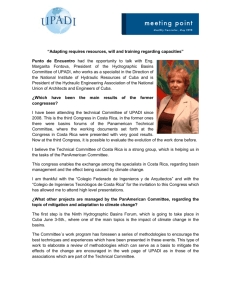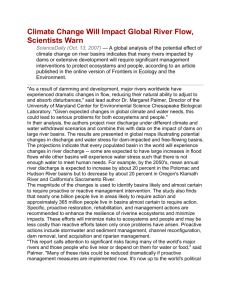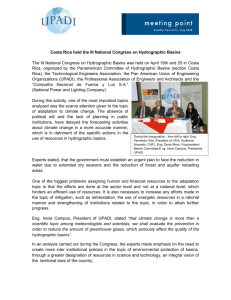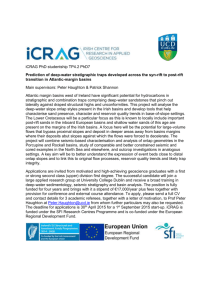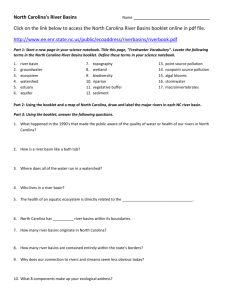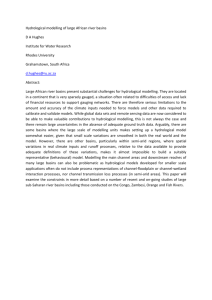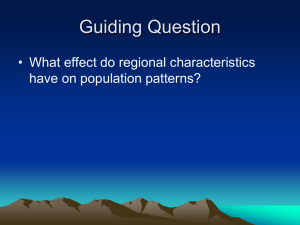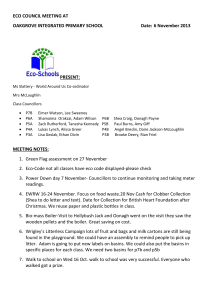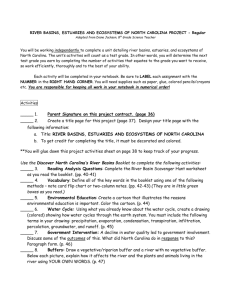Transboundary Water Issues & Judicial Solutions
advertisement
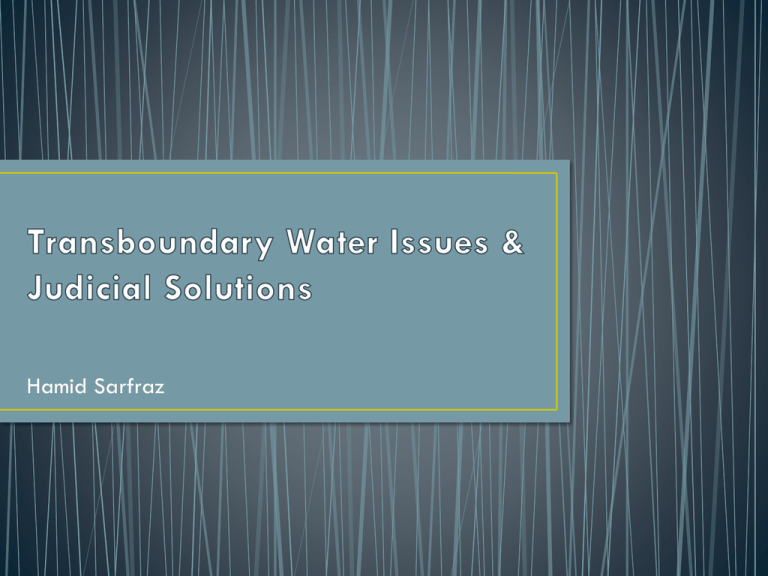
Hamid Sarfraz • Rival – originated in the late 16th century from Latin rivalis, originally in the sense 'person using the same stream as another', from rivus 'stream'. • Conflicts since the Neolithic revolution; when humans settled down to cultivate food between 8,000 and 6,000 BC. • International water treaties date as far back as 2500 BC, when the two Sumerian city-states of Lagash and Umma crafted an agreement ending a water dispute along the Tigris River • • • • 263 transboundary watersheds/basins cover 45.3% of the land surface of the earth affect about 40% of the world’s population account for approximately 60% of global river flow • The problem is growing – 214 international basins listed in a 1978 UN study and 263 today, largely due to political changes and access to mapping technology • 145 nations include territory within international basins 21 nations lie in their entirety within international basins 33 countries have greater than 95% of their territory within these basins • 19 basins are shared by five or more riparian countries • 158 (60%) international basins lack any type of cooperative management framework • Of the 106 basins with water institutions, approximately 2/3rd have three or more riparian states, yet more than 80% of the accompanying agreements are bilateral • Climatic variability and uncertainty in river flows • Rapid population growth, industrialisation and urbanisation resulting in high demand for energy • Environmental flows – a new demand • High rate of groundwater extraction • Regionalisation vis-à-vis bilateralism • Proliferation of democracy http://www.internationalwaterlaw.org/ • Diversion of Water from the Meuse (Netherlands v. Belgium) • Oscar Chinn (Britain v. Belgium) • Territorial Jurisdiction of the International Commission of the Oder River • Jurisdiction of the European Commission of the Danube Between Galatz and Braila • Road Construction in Costa Rica along San Juan River (Nicaragua v. Costa Rica) • Activities by Nicaragua in the Border Area (Costa Rica v. Nicaragua) • Pulp Mills on the River Uruguay (Argentina v. Uruguay) • Dispute regarding Navigational and Related Rights (Costa Rica v. Nicaragua) • Frontier Dispute (Republic of Benin v. Republic of Niger) • Kasikili/Sedudu Island (Botswana v. Namibia) • Gabcikovo-Nagymaros Project (Hungary v. Slovakia) • Land, Island, and Maritime Frontier Dispute (Honduras v. El Salvador) 1986, 2003 • Indus Waters Kishenganga Arbitration (Pakistan v. India) Area 120 m ha Irrigates 20 m acres Eastern Rivers – 33 MAF Western Rivers – 136.1 MAF 215 million people • • • • • Pre partition conflicts 6 rivers flowing from India with 2 major head-works in India Standstill Agreement (18 Dec 1947) Inter-Dominion Agreement (4 May 1948) 1960 Indus Waters Treaty Divisive in nature, hence ‘equitable and reasonable utilisation’ is elusive Failed to cope with hydrological extremes Lacks environmental protection, preservation and management Survived two full scale wars and regular ‘wars of words’ Still partially relevant and viable with a need to align with new realities • Article IX: Settlement of Differences and Disputes • Indus Waters Commission to decide the course of settlement • Indus Water Treaty to be the applicable law, but also: International conventions establishing rules which are expressly recognized by the Parties Customary international law Indus Water Commissioners Neutral Expert Negotiators Court of Arbitration Baglihar • Neutral Expert appointed by WB • 2005-2007 • Win-win determination India allowed to construct dam with some design changes Pakistan’s objections regarding pondage and dam’s crest elevation accepted Both parties agreed to the determination Kishenganga • • • • PCA Mar 2010 to date EIA recognised and demanded Partial award India allowed to construct Run-ofRiver Plant through diverting water but maintaining the minimum flow of water at a rate to be determined by PCA India not permitted reduction below “Dead Storage Level” of the water level in the reservoirs of Run-of-River Plants • Can both countries afford it to be a business as usual? • Building upon the success of IWT – Addendum • Cooperative water management through Joint research in the areas of climate change, hydrogeology, glaciology, and geo-informatics through GIS based data collection and sharing systems Mutual understanding and agreement on a timeframe for storage and release of water in a mutually beneficial manner Joint adaption strategy to offset the impacts of climate change Catering the environmental flow needs Joint water development and energy generation Cost and benefit sharing • Ratification of UNWC by both states • Set an example for other conflicts in the region … but the water problems of our world need not be only a cause of tension; they can also be a catalyst for cooperation…If we work together, a secure and sustainable water future can be ours. - Kofi Annan, February 2002 hsarfraz@gmail.com www.devconsult.pk
